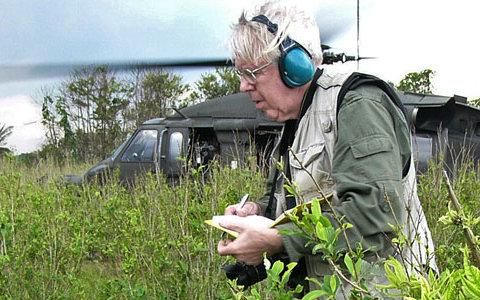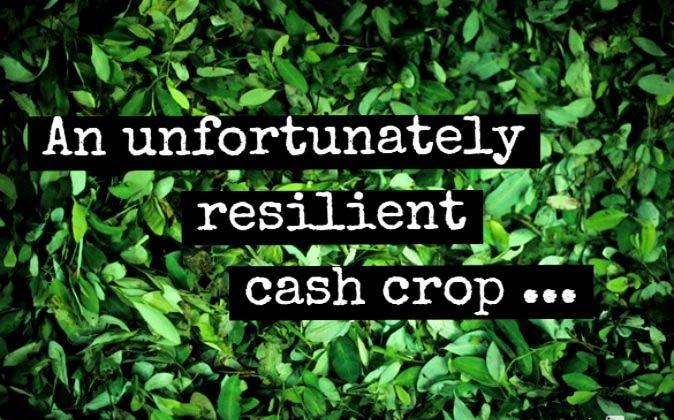The plant at the heart of the cocaine trade has survived decades of efforts to eradicate it. What’s a little global warming going to do?
Few cry for the cocaleros.
Cocaine is the bane of law enforcement across the Americas. But both the drug and the coca farmers – known in Spanish as cocaleros– who cultivate the drug’s source face the same threats as any other crop or product in our warming climate.
Except that cocaine appears ready for the challenges.

The coca bush is the raw material for a lucrative and often-violent drug trade and the target of decades of international eradication efforts. It has funded civil wars and contributed to climate change, as cocaleros cut down forests in the Andean nations of Colombia, Peru and Bolivia to plant more of the shrubs.
But while scientists have raised alarms about the potential threats climate change may pose to other tropical commodities like chocolate and coffee, little effort has been spent exploring what an era of rising temperatures could mean for coca. Most research in the past few decades has been aimed at finding new ways to kill it.
“There’s the beginnings of a more open debate about drug policy in the Western Hemisphere and Latin America, but the question of coca cultivation remains very prickly,” said John Walsh, a drug policy analyst at the Washington Office on Latin America, a U.S.-based think tank. “Obviously, because it’s the raw material for cocaine, and cocaine remains if not pubic enemy No. 1, then pretty high on the list in most people’s point of view.”
A Tough Plant
In general, the coca belt is expected to be hotter and drier in the coming century. Average temperatures could rise by as much as 4 degrees Celsius (7.2º Fahrenheit) by 2100, the U.N.’s Intergovernmental Panel on Climate Change reported in late March. Areas closer to the equator are expected to get more rainfall, while those to the north and south are expected to get less. The glaciers of the tropical Andes are receding, and the ranges of many plants are shifting upward toward cooler, higher elevations, the IPCC noted.
But the coca bush is a tough plant, one that’s likely to adapt to the expected changes, say several scientists who’ve studied cocaine.
“Coca is kind of unique, because it’s got a very heavy wax cuticle, a layer on the leaves,” said Charles Helling, a former soil chemist at U.S. Department of Agriculture who took part in American anti-drug efforts. “So that tends to protect it from water loss. It’s a pretty hardy shrub. It’s actually a lot hardier than a typical crop plant.”
Neither the Drug Enforcement Agency nor the U.N. Office on Drugs and Crime nor the Inter-American Drug Abuse Control Commission, an arm of the Organization of American States, have examined the potential effects of climate change on the crop, representatives of those agencies said. UNODC spokeswoman Preeta Bannerjee said her agency uses satellites to monitor coca-growing areas, “but we don’t measure the impact on the environment,” she said.
A Longer Dry Season
Observers are already seeing a longer dry season in places like subtropical Peru, said Kenneth Young, a University of Texas geographer who has studied the country for more than 20 years. But he said coca already has adapted to as little as 500 mm, or 20 inches, of rainfall a year – about the same as Boulder, Colo. Mostly coca grows in areas that today receive between three and four times that amount.
“It’s a wet, tropical forest plant, and making it a little bit drier is not going to dramatically change it,” he said. And if coca bushes do dry up, the cocaleros are likely to seek out a variety “that’s a little more robust.”
And Helling said warming may not only do little to hurt the crop, it might open up more space to grow it at higher elevations. But on the whole, he predicted that climate change will be a wash when it comes to cocaine, as growers adapt to less rainfall by relying more on irrigation.
“I’ve seen some amazing, shall we say, agronomic setups down in Colombia particularly,” said Helling, who worked for the State Department’s anti-drug office in Colombia for three years after retiring from the USDA in 2007.
Traditional Uses
One coca farm he studied in Colombia was a former cattle ranch, “more of the kind of place where cacti were. But you could grow coca perfectly well if you irrigated it.” And if warmer temperatures led to a higher risk of disease or insect infestation, “growers will undoubtedly use more chemicals to prevent it,” he said.
Some indigenous South American populations still use coca for medicinal purposes – particularly in Bolivia, led by former cocalero Evo Morales. It’s chewed or brewed into a tea, often offered to visitors struggling with the high altitude.
Under Morales, Bolivia has allowed limited, legal coca cultivation while cracking down on illicit crops. In June, UNODC reported that Bolivia’s coca production shrank by 9 percent in 2013 and was down 26 percent in the past three years.
But though traditional uses persist, UNODC says most of the South American coca crop ends up as cocaine on the streets of Europe and North America, where it’s long been a favored pick-me-up of the rich and the scourge of the inner-city poor.
Supply Droughts and Ugly Turns
Marshall Rancifer knows the latter well. He’s a former crack cocaine addict who’s now an anti-drug counselor and outreach director for the Atlanta nonprofit Someone Cares. His job involves seeking out current users and prostitutes who turn tricks to support their habits.
He doesn’t think climate change will make a dent in the drug supply in Atlanta. But if it does, he says, watch out: Previous supply droughts have been ugly.
“It’s happened before, when big shipments get busted or for whatever reason supply gets low,” said Rancifer.
“Demand is always high, and then they start cutting the dope down” – diluting the product with anything from baking soda to baby laxative. The temptation to boost the adulterated drug’s potency is high, he said.
“Sometimes they get very inventive and put other stuff in the dope, so you get the sense that you’re not losing anything when you’re getting high,” he said. “That’s where we start having a lot of overdose deaths.”
And then there are the shootings.
“You see an uptick in violence because people are not getting the high that they expected,” Rancifer said. Addicts get angry with dealers, who move in on rivals’ corners, “and then you’ve got a drug turf war.”
“Nothing good comes out of a shortage of dope when it comes to people using and selling,” Rancifer said.
Cash Crop
The money is likely to keep the cocaleros in business, even if it takes more effort to produce a crop. If someone’s buying cocaine, someone will be growing coca, said Walsh, the drug policy analyst.
“The main driver is there is global demand, and it is fully a globalized transnational industry,” he said. The United States and other countries have tried spraying herbicides on coca fields and encouraging Andean peasants to grow other crops, but coca “provides a better return than say, plantains,” he added.
And if climate change hurts other sectors of the economy, it could drive more people to start growing coca. That’s what happened in Bolivia in the 1980s, when the country’s tin mining industry went bust: Miners and their families moved to the country’s Chapare region and took up coca farming. It’s easy to grow, can be cultivated several times a year and the market “almost comes to them,” Walsh said.
But at this point, there’s little that can be said authoritatively about how coca itself may fare. Helling, the retired USDA soil chemist, said that if climate change accomplished what decades of eradication efforts didn’t, “nobody would be shedding any tears.”
But if the weather did change enough to affect coca, he cautioned, “there are a host of legal crops we'll have to be worrying about more.”
Republished with permission from The Daily Climate. Read the original.




Friends Read Free